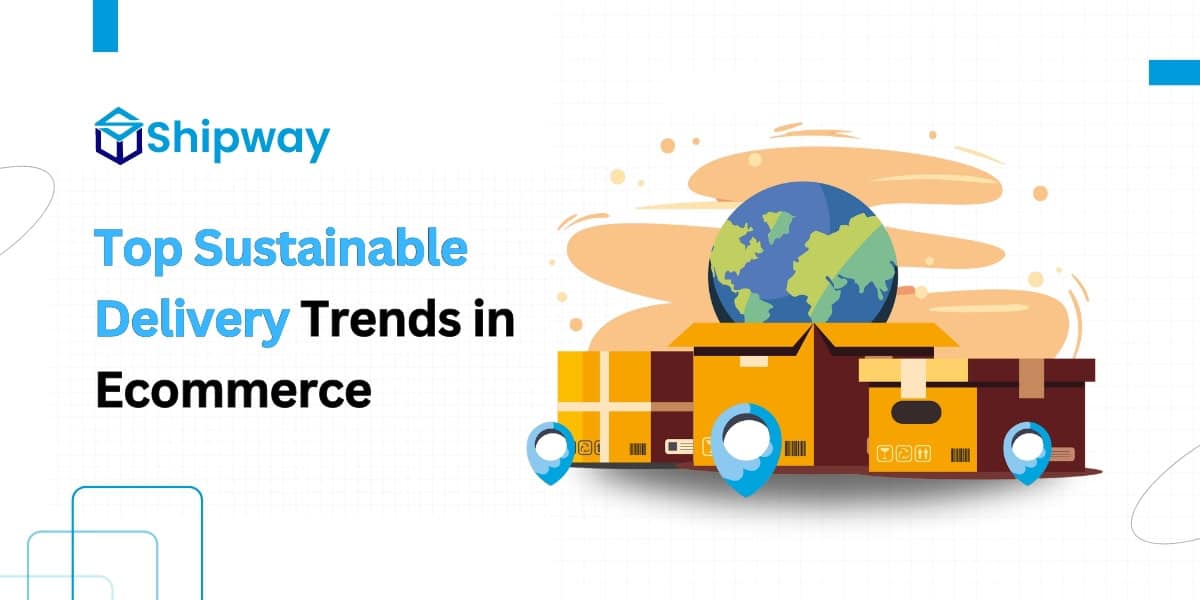India is witnessing a phenomenal rise in online shopping as the eCommerce industry is set to reach US$300 billion by 2030.
This compels eCommerce companies to not just deliver products but also do it with utmost sustainability. Because eight out of ten shoppers prefer more sustainable delivery options for their online orders. This means businesses should seek more greener options to deliver products.
So, if you are an eCommerce player feeling the weight of sustainable deliveries, do not fret! In 2025, it’s time to explore a few sustainable delivery trends as an opportunity (rather than a challenge) to become a key differentiator in a highly competitive market.
Let’s explore those in detail.
1. Use of Electric Vehicle for Last-Mile Delivery
India is set to witness an EV adoption for the last mile as they can make up for roughly 25-30% of all last-mile delivery fleets in India.
This is why major players are investing heavily in India’s EV explosion. The lower long-term costs, incentives for reducing carbon footprints, and consumer preference for eco-friendly delivery options motivate them.
But it’s not just about replacing the engines. The entire ecommerce shipping ecosystem is adapting as we see the growing trends of the following:
Micro-fulfillment centers
Smaller, localized warehouses pave the way for overnight shipping to win customers with faster delivery. Micro-fulfillment centers can equip efficient EV delivery routes to minimize ‘deadhead’ miles (empty return trips).
Charging infrastructure investment
Retailers and governments are offering resources to expand charging networks, making it easier for EVs to keep rolling.
Delivery robots
While still in the early stages, autonomous delivery robots are popping up in selected cities, offering a glimpse of a zero-emission future.
2. Reverse Logistics Optimization
Reverse logistics involves managing the flow of goods from the end consumer back through the supply chain. These are usually the returns customers must make for unsatisfactory products. Optimizing reverse logistics requires eCommerce companies to transform returns into valuable resources to reduce waste and promote sustainability.
So, how do you actually optimize the returns?
It starts with investing in logistics CRM (Customer Relationship Management). This will help track and analyze customer returns data to glean valuable insights.
Optimizing the reverse logistics will require taking the following actions:
Data-Driven Returns Management
Logistics CRM systems provide valuable data on customer returns, including reasons for returns, product types, and customer demographics. This data can be used to identify patterns and root causes, enabling companies to proactively address product design, quality control, and customer service issues. This leads to reduced waste, returns and write-offs and most importantly, improved customer satisfaction.
Partnerships with Recycling and Refurbishment Companies
A part of a sustainable delivery mechanism involves handling returns and discarded products. This requires collaboration with specialized companies to find sustainable solutions that are not marked for reselling and ensure that valuable materials are recovered and reused.
Efficient Returns Processing
Managing customers’ returns requires a well-designed system to assess their condition quickly. Streamlining returns requires automated tasks like return authorization, label generation, and tracking. Reduces labor costs and improves the customer experience by providing greater transparency and faster processing times.
This is done where returns are segregated. If returned products are new-like, they go back on the shelf. If they need minor repairs, they get fixed up for resale. If they’re damaged beyond repair, the materials are recycled responsibly. Accordingly, arrange and fix the pickups in a streamlined approach to save time and money and keep products out of landfills.
3. Circular Packaging Solutions
Circular packaging is a sustainable approach to minimize waste by keeping materials in use as long as possible. It departs from the traditional ‘take-make-waste’ model as eco-conscious consumers demand more sustainable options in deliveries and packaging.
The usability, recyclability, and compostability take center stage, reflecting a fundamental rethinking of how goods are packaged and shipped.
Regulators are also cracking down on wasteful practices. For instance, the EU passed a bill requiring businesses to opt for circular packaging that is at least 70% recyclable per unit in weight.
The eCommerce businesses can adopt circular packaging solutions for deliveries to reduce their environmental footprint and appeal to a large section of eco-conscious consumers.
This packaging approach for eCommerce delivery is about creating a closed loop where materials remain in the packaging ecosystem to minimize waste in the following ways:
Reusing
Reusing the packages that can be returned and used multiple times, like returnable boxes or refillable containers.
Recycling
Recycling the product packages created from materials quickly processed into new products, like cardboard or certain types of plastic.
Composting
Composting the packages made from organic materials that can break down naturally and safely return to the earth.
4. Optimized Routing and Consolidation
There are no longer haphazard delivery routes in eCommerce delivery, which could waste time and fuel and contribute to unnecessary emissions.
It is 2025, and sustainable delivery is all about working smarter by leveraging cutting-edge route planning software with data analytics.
Optimized routing uses technologies like as mentioned below:
AI-Powered Route Optimization Software
Using complex algorithms to analyze vast amounts of data and calculate the most efficient delivery routes.
GPS Tracking and Telematics
Real-time location tracking of delivery vehicles allows dispatchers to track progress, monitor driver behavior, and adjust as needed. Telematics systems gather data on vehicle performance, fuel consumption, and driving habits to identify areas for further optimization.
Flexible Delivery Windows
Companies can batch deliveries more strategically by offering customers a choice of delivery time slots. This means fewer trips, less mileage, and a smaller carbon footprint.
5. Carbon Offsetting and Renewable Energy
Electric vans and optimized routes alone won’t save the planet. Truly decarbonizing eCommerce delivery requires bolder steps. It requires embracing strategies to tackle emissions at their source. That’s where carbon offsetting and renewable energy step in, paving the way for a future with net-zero emissions.
Let’s understand both briefly.
Carbon Offsetting
A mechanism where businesses invest in projects to reduce or remove greenhouse gases from the atmosphere.
These projects involve reforestation initiatives for absorbing CO2 to make investments in renewable energy that displace fossil fuels. Ecommerce businesses can purchase carbon offsets to effectively “balance” their emissions with equivalent reductions elsewhere, achieving a net-zero impact. To accurately report on logistics emissions, brands should integrate carbon reporting tools that measure
cradle-to-grave impact before offsetting
Renewable Energy
Next is renewable energies, where eCommerce businesses invest in sources like solar and wind power, which are cornerstones of sustainable delivery.
This means building warehouses, charging electric vehicles, and even running their operations with renewable energy. It can thus dramatically reduce their carbon footprint, helping the environment and shielding businesses from volatile fossil fuel prices. Also, eco-conscious customers would see this commitment to sustainability and build trust, driving more purchases.
A powerful synergy between carbon offsetting and renewable energy creates a ripple effect impacting the last mile delivery in different ways as follows:
- Cleaner Fleets: Renewable energy can replace fuel-driven vehicles to run electric vehicle deliveries. This rests on charging infrastructure to eliminate tailpipe emissions contributing to local air pollution.
- Greener Warehouses: Solar panels on warehouse roofs generate clean energy for charging the last-mile delivery fleet. This can reduce dependence on fossil fuels while lowering overall emissions.
Wrapping Up
As eCommerce continues to flourish, businesses should tap into the latest sustainable delivery trends we’ve explored. These sustainable delivery trends in 2025 are just the beginning because consumers demand greener choices, and regulations are bound to get tighter.
Hence, eCommerce companies should embrace these trends as a corporate social responsibility. This requires consistent investments in sustainable delivery solutions to reduce their environmental impact. It will also enhance their brand reputation, attract loyal customers, and ultimately thrive in a rapidly changing market.
The road to net-zero emissions in ecommerce shipping is undoubtedly challenging. Still, it’s a journey worth taking so that the convenience of online shopping doesn’t come at the expense of the planet.

Author Bio:
Taher Batterywala is a creative marketer who loves to write & design content that organically drives conversions. He is the creator of Pineable, the world’s first content marketing design inspiration hub. He regularly shares his thoughts about content marketing, SEO and design. As a true cinephile, he admires movies above anything else.


